Improving Laser Powder Bed Fusion Printability of Tungsten Powders Using Simulation-Driven Process Optimization Algorithms
Abstract
1. Introduction
2. Materials and Methods
2.1. Powder Characterization
2.2. Building the Printed Density Processing Map
2.2.1. Theoretical Considerations
- Powder bed density
- Powder bed absorptivity
- Powder bed thermal conductivity
- Simplifications related to the temperature dependence of tungsten properties
2.2.2. Relating the Melt Pool Dimensions to Printed Density
2.2.3. Processing Map in the VED-BR Coordinates

2.3. Experiments and Equipment
- Image analysis material density (ρIM), calculated as a white-to-black pixel ratio in the binarized image; the binarization procedure was applied using the “im2gray” function and a threshold specific to each image. Additionally, the “imfill” function was used to fill the holes and ensure that each pore was entirely black, with no embedded white pixels (Figure 8a,b).
- Pores density (Number of pores per mm2, p.mm−2), which represents the sum of all the detected pores divided by the image area.
- The 10, 50 and 90% quotients of an entire pore population in terms of their equivalent diameter (DE10p, DE50p and DE90p, µm), obtained by plotting the surface-based distribution of the equivalent pore diameters (Figure 8c). The equivalent diameter of a pore corresponds to the diameter of a circle having the same surface area as the pore, calculated using Equation (13).
- The 10, 50 and 90% quotients of an entire pore population in terms of their circularity (C10p, C50p, C90p, without unit) obtained by plotting the surface-based distribution of the pore circularity (Figure 8d). The circularity of a pore was calculated using Equation (14):
- Ultimate compression strength (UCS, MPa), defined as the maximum stress reached during the test.
- Yield strength at 0.2% offset (YS, MPa), calculated by moving the slope at the origin (slope O) to 0.2% on the strain axis, according to the methodology described in the standard.
- Strain under maximum load (δ, %), representing the difference between the total compression strain and the elastic strain to failure, calculated by moving the slope at origin (slope O) to reach the UCS.
3. Results
3.1. Archimedes- and Image-Measured Printed Densities
3.2. Predicted versus Measured Printed Density
3.3. Structural Studies
3.3.1. Porosity
3.3.2. Grain Structure
3.4. Compression Testing
3.5. Analyses of the Crystalline Phases and Oxides
3.6. Printable Geometric Features
4. Discussion
- For both layer thicknesses and both lasers, the predicted printed density evolves similarly: it increases as a function of the h/t to reach a maximum and then decreases. Globally, the thinner the layer thickness, the larger the recommended h/t ratio, irrespective of the laser power. In more detail, for the 200 W laser, when the layer thickness decreases from 30 to 20 μm, the recommended h/t value increases from 2.5 to 3, (stars, Figure 23a), and for the 400 W laser, when the layer thickness decreases from 30 to 20 μm, the recommended h/t value increases from 3 to 3.5 (triangles, Figure 23a).
- Printing with both devices using the same VED-BR set leads to the following conclusion: the thinner the layers, the higher the predicted density, where the maximum predicted density for a 200 W laser is 97%, while for a 400 W laser, this density is 95%.
- Trends of the predicted density according to the h/t ratio are the same as in the previous numerical study. Also, for the 400 W printer, h/t leading to the maximum predicted density is 3, irrespective of the layer thickness, meaning that no improvements can be made to 400 W printers using thinner layers.
- Considering the optimal printing parameters for each of the printers, the 400 W printer leads to a higher maximum predicted density than the 200 W printer: 99 as compared to 97%.
5. Conclusions
- A numerical model based on simple analytical considerations of the LPBF process was developed to calculate the melt pool dimensions and predict the part density. The melt pool calculations have been validated using experimental data taken from the literature, and the density predictions were validated through experiments.
- Structural analyses revealed that the specimens are crack-free, but some of them possess unfused powder particles inside the pores, which means that the Archimedes’ measurements overestimate the part density.
- A strong link between the physical and mechanical properties of the printed specimens and the process parameters was established, namely that:
- a.
- Density and strength first increase and then decrease according to the h/t ratio, whatever the selected - set.
- b.
- A ratio of h/t = 2.7 was established as the best for all the - sets.
- c.
- A J.mm−3 − cm3.h−1 parameters set was found to lead to the best properties irrespective of the h/t value.
- Using the defined optimal set of parameters, gyroid lattice structures and wall and gap artifacts were printed. The comparisons between the nominal and the measured characteristics enable the conclusion that this set of parameters also leads to good printability and small printable limits.
- Comparisons with the literature followed by numerical studies using the developed model revealed that the printed density can be improved when considering thinner layers, more powerful LPBF devices, post-treatments and alloying. Also, the processing parameters must be specifically optimized for each individual printer and powder feedstock when such changes are made.
6. Future Work
Author Contributions
Funding
Institutional Review Board Statement
Informed Consent Statement
Data Availability Statement
Acknowledgments
Conflicts of Interest
Appendix A
| Name | Hatching Space (µm) | Power (W) | Speed (mm.s−1) | Volumetric Energy Density (J.mm−3) | Built Rate (cm3.h−1) | Predicted Density (%) | Image Analysis Density (%) | Absolute Error between Densities (%) |
|---|---|---|---|---|---|---|---|---|
| A-20 | 20 | 140 | 200 | 1167 | 0.43 | 86.9 | 87.4 | 0.5 |
| B-20 | 89 | 197 | 750 | 0.43 | 72.8 | 82.6 | 9.9 | |
| C-20 | 179 | 398 | 750 | 0.86 | 89.7 | 84.7 | 5.0 | |
| D-20 | 100 | 398 | 417 | 0.86 | 72.8 | 69.5 | 3.3 | |
| E-20 | 188 | 750 | 417 | 1.62 | 87.2 | 78.3 | 8.9 | |
| A-30 | 30 | 140 | 133 | 1167 | 0.43 | 90.2 | 87.7 | 2.5 |
| B-30 | 89 | 131 | 750 | 0.43 | 78.2 | 75.9 | 2.3 | |
| C-30 | 179 | 265 | 750 | 0.86 | 93.8 | 92.4 | 1.4 | |
| D-30 | 188 | 500 | 417 | 0.86 | 78.2 | 82.1 | 3.9 | |
| E-30 | 100 | 265 | 417 | 1.62 | 92.2 | 82.6 | 9.6 | |
| A-40 | 40 | 140 | 100 | 1167 | 0.43 | 91.9 | 88.3 | 3.6 |
| B-40 | 90 | 100 | 750 | 0.43 | 77.4 | 78.5 | 1.2 | |
| C-40 | 179 | 199 | 750 | 0.86 | 94.8 | 89.8 | 5.0 | |
| D-40 | 188 | 375 | 417 | 0.86 | 77.4 | 80.5 | 3.1 | |
| E-40 | 100 | 200 | 417 | 1.62 | 93.4 | 91.4 | 1.9 | |
| A-60 | 60 | 140 | 67 | 1167 | 0.43 | 91.1 | 90.2 | 0.9 |
| B-60 | 90 | 67 | 750 | 0.43 | 74.6 | 90.2 | 15.6 | |
| C-60 | 179 | 133 | 750 | 0.86 | 95.1 | 88.2 | 6.9 | |
| D-60 | 100 | 133 | 417 | 0.86 | 78.3 | 78.4 | 0.1 | |
| E-60 | 188 | 250 | 417 | 1.62 | 94.2 | 92.1 | 2.1 | |
| A-80 | 80 | 140 | 50 | 1167 | 0.43 | 91.2 | 91.2 | 0.0 |
| B-80 | 180 | 100 | 750 | 0.43 | 72.1 | 84.3 | 12.3 | |
| C-80 | 89 | 49 | 750 | 0.86 | 94.2 | 89.2 | 5.0 | |
| D-80 | 188 | 188 | 417 | 0.86 | 78.2 | 85.9 | 7.7 | |
| E-80 | 100 | 100 | 417 | 1.62 | 94.2 | 93.2 | 1.1 | |
| A-100 | 100 | 140 | 40 | 1167 | 0.43 | 89.7 | 91.2 | 1.5 |
| B-100 | 90 | 40 | 750 | 0.43 | 70.0 | 83.5 | 13.5 | |
| C-100 | 179 | 80 | 750 | 0.86 | 93.9 | 93.5 | 0.4 | |
| D-100 | 188 | 150 | 417 | 0.86 | 76.3 | 81.5 | 5.2 | |
| E-100 | 100 | 80 | 417 | 1.62 | 93.1 | 91.8 | 1.3 |
Appendix B
| Name | Pore Density (p.mm−2) | Pore Size DE50p (µm) | YS at 0.2% (MPa) | UCS (MPa) | Strain under Maximum Load (%) | Maximum Compression Strain (mm.mm−1) |
|---|---|---|---|---|---|---|
| A-20 | 101 | 95 | 357 | 460 | 2.9 | 0.10 |
| B-20 | 166 | 85 | 222 | 335 | 3.8 | 0.08 |
| C-20 | 123 | 120 | 315 | 415 | 2.6 | 0.07 |
| D-20 | 128 | 120 | 274 | 392 | 4.2 | 0.11 |
| E-20 | 92 | 125 | 320 | 425 | 3.3 | 0.09 |
| A-30 | 195 | 80 | 418 | 592 | 5.4 | 0.13 |
| B-30 | 120 | 100 | 258 | 449 | 6.0 | 0.11 |
| C-30 | 157 | 95 | 537 | 705 | 2.9 | 0.07 |
| D-30 | 119 | 85 | 288 | 459 | 5.7 | 0.11 |
| E-30 | 75 | 120 | 376 | 542 | 4.7 | 0.10 |
| A-40 | 96 | 85 | 323 | 549 | 5.3 | 0.12 |
| B-40 | 187 | 85 | 275 | 492 | 6.8 | 0.12 |
| C-40 | 114 | 90 | 547 | 635 | 3.5 | 0.11 |
| D-40 | 292 | 80 | 376 | 631 | 8.1 | 0.14 |
| E-40 | 117 | 95 | 544 | 694 | 3.5 | 0.09 |
| A-60 | 112 | 90 | 513 | 739 | 6.7 | 0.13 |
| B-60 | 209 | 75 | 396 | 629 | 7.7 | 0.14 |
| C-60 | 116 | 90 | 526 | 652 | 3.8 | 0.09 |
| D-60 | 225 | 80 | 394 | 599 | 7.6 | 0.13 |
| E-60 | 106 | 90 | 669 | 810 | 3.3 | 0.09 |
| A-80 | 116 | 70 | 458 | 735 | 8.4 | 0.14 |
| B-80 | 185 | 75 | 347 | 617 | 10.2 | 0.16 |
| C-80 | 149 | 85 | 540 | 651 | 2.9 | 0.08 |
| D-80 | 143 | 70 | 396 | 671 | 11.0 | 0.18 |
| E-80 | 76 | 80 | 676 | 867 | 6.9 | 0.15 |
| A-100 | 192 | 60 | 521 | 799 | 9.6 | 0.16 |
| B-100 | 244 | 70 | 368 | 655 | 10.7 | 0.17 |
| C-100 | 195 | 65 | 584 | 803 | 6.6 | 0.12 |
| D-100 | 206 | 85 | 449 | 662 | 9.0 | 0.17 |
| E-100 | 158 | 75 | 591 | 777 | 5.9 | 0.11 |
References
- ASM International. Metals Handbook, 2nd ed.; Desk Edition; Davis, J.R., Ed.; ASM International: Materials Park, OH, USA, 1998; ISBN 978-0-87170-654-6. [Google Scholar]
- Bilewska, K. Report on Refractory Metal Reduction Potential; Łukasiewicz Research Network—Institute of Non-Ferrous Metals: Gliwice, Poland, 2016; p. 68. [Google Scholar]
- Enneti, R.K.; Trasorras, J.L.; Kestler, H. Additive Manufacturing of Tungsten, Molybdenum, and Cemented Carbides. In Additive Manufacturing Processes; Bourell, D.L., Frazier, W., Kuhn, H., Seifi, M., Eds.; ASM International: Materials Park, OH, USA, 2020; pp. 380–387. ISBN 978-1-62708-290-7. [Google Scholar]
- Talignani, A.; Seede, R.; Whitt, A.; Zheng, S.; Ye, J.; Karaman, I.; Kirka, M.M.; Katoh, Y.; Wang, Y.M. A Review on Additive Manufacturing of Refractory Tungsten and Tungsten Alloys. Addit. Manuf. 2022, 58, 103009. [Google Scholar] [CrossRef]
- Colomo, A.G.; Wood, D.; Martina, F.; Williams, S.W. A Comparison Framework to Support the Selection of the Best Additive Manufacturing Process for Specific Aerospace Applications. Int. J. Rapid Manuf. 2020, 9, 194–211. [Google Scholar] [CrossRef]
- Dzogbewu, T.C.; De Beer, D. Powder Bed Fusion of Multimaterials. JMMP 2023, 7, 15. [Google Scholar] [CrossRef]
- Metal Additive Manufacturing—Tungsten 3D Printing; M&I Materials Ltd.: Manchester, UK, 2023; Available online: https://www.wolfmet.com/applications/slm/selective-laser-melting-tungsten/ (accessed on 5 October 2023).
- Tungsten for Industrial 3D Printing|EOS. Available online: https://www.eos.info/en/3d-printing-materials/metals/refractory-metals (accessed on 5 October 2023).
- Braun, J.; Kaserer, L.; Stajkovic, J.; Leitz, K.-H.; Tabernig, B.; Singer, P.; Leibenguth, P.; Gspan, C.; Kestler, H.; Leichtfried, G. Molybdenum and Tungsten Manufactured by Selective Laser Melting: Analysis of Defect Structure and Solidification Mechanisms. Int. J. Refract. Met. Hard Mater. 2019, 84, 104999. [Google Scholar] [CrossRef]
- Müller, A.V.; Schlick, G.; Neu, R.; Anstätt, C.; Klimkait, T.; Lee, J.; Pascher, B.; Schmitt, M.; Seidel, C. Additive Manufacturing of Pure Tungsten by Means of Selective Laser Beam Melting with Substrate Preheating Temperatures up to 1000 °C. Nucl. Mater. Energy 2019, 19, 184–188. [Google Scholar] [CrossRef]
- Rebesan, P.; Bonesso, M.; Gennari, C.; Dima, R.; Pepato, A.; Vedani, M. Tungsten Fabricated by Laser Powder Bed Fusion. Berg Huettenmaenn. Monatsh. 2021, 166, 263–269. [Google Scholar] [CrossRef]
- Tan, C.; Zhou, K.; Ma, W.; Attard, B.; Zhang, P.; Kuang, T. Selective Laser Melting of High-Performance Pure Tungsten: Parameter Design, Densification Behavior and Mechanical Properties. Sci. Technol. Adv. Mater. 2018, 19, 370–380. [Google Scholar] [CrossRef] [PubMed]
- Wang, D.; Yu, C.; Zhou, X.; Ma, J.; Liu, W.; Shen, Z. Dense Pure Tungsten Fabricated by Selective Laser Melting. Appl. Sci. 2017, 7, 430. [Google Scholar] [CrossRef]
- Xiong, Z.; Zhang, P.; Tan, C.; Dong, D.; Ma, W.; Yu, K. Selective Laser Melting and Remelting of Pure Tungsten. Adv. Eng. Mater. 2020, 22, 1901352. [Google Scholar] [CrossRef]
- Sidambe, A.T.; Fox, P. Interaction of pure tungsten powder with processing conditions in selective laser melting. In Proceedings of the 2017 International Conference on Powder Metallurgy and Particulate Materials, Las Vegas, NV, USA, 13–16 June 2017; pp. 701–711. [Google Scholar]
- Guo, M.; Gu, D.; Xi, L.; Zhang, H.; Zhang, J.; Yang, J.; Wang, R. Selective Laser Melting Additive Manufacturing of Pure Tungsten: Role of Volumetric Energy Density on Densification, Microstructure and Mechanical Properties. Int. J. Refract. Met. Hard Mater. 2019, 84, 105025. [Google Scholar] [CrossRef]
- Li, J.; Wu, Y.; Zhou, B.; Wei, Z. Laser Powder Bed Fusion of Pure Tungsten: Effects of Process Parameters on Morphology, Densification, Microstructure. Materials 2020, 14, 165. [Google Scholar] [CrossRef] [PubMed]
- Marrey, M.; Malekipour, E.; El-Mounayri, H.; Faierson, E.J. A Framework for Optimizing Process Parameters in Powder Bed Fusion (PBF) Process Using Artificial Neural Network (ANN). Procedia Manuf. 2019, 34, 505–515. [Google Scholar] [CrossRef]
- Gor, M.; Dobriyal, A.; Wankhede, V.; Sahlot, P.; Grzelak, K.; Kluczyński, J.; Łuszczek, J. Density Prediction in Powder Bed Fusion Additive Manufacturing: Machine Learning-Based Techniques. Appl. Sci. 2022, 12, 7271. [Google Scholar] [CrossRef]
- Chen, H.; Sun, Y.; Yuan, W.; Pang, S.; Yan, W.; Shi, Y. A Review on Discrete Element Method Simulation in Laser Powder Bed Fusion Additive Manufacturing. Chin. J. Mech. Eng. Addit. Manuf. Front. 2022, 1, 100017. [Google Scholar] [CrossRef]
- Todo, T.; Ishimoto, T.; Gokcekaya, O.; Oh, J.; Nakano, T. Single Crystalline-like Crystallographic Texture Formation of Pure Tungsten through Laser Powder Bed Fusion. Scr. Mater. 2022, 206, 114252. [Google Scholar] [CrossRef]
- Vrancken, B.; Ganeriwala, R.; Matthews, M. Local Strain Release Due to Microcracking in Laser Melted Tungsten. Procedia CIRP 2022, 111, 148–152. [Google Scholar] [CrossRef]
- Chowdhury, S.; Yadaiah, N.; Prakash, C.; Ramakrishna, S.; Dixit, S.; Gupta, L.R.; Buddhi, D. Laser Powder Bed Fusion: A State-of-the-Art Review of the Technology, Materials, Properties & Defects, and Numerical Modelling. J. Mater. Res. Technol. 2022, 20, 2109–2172. [Google Scholar] [CrossRef]
- Sharma, S.; Krishna, K.V.M.; Joshi, S.S.; Radhakrishnan, M.; Palaniappan, S.; Dussa, S.; Banerjee, R.; Dahotre, N.B. Laser Based Additive Manufacturing of Tungsten: Multi-Scale Thermo-Kinetic and Thermo-Mechanical Computational Model and Experiments. Acta Mater. 2023, 259, 119244. [Google Scholar] [CrossRef]
- Promoppatum, P.; Yao, S.-C.; Pistorius, P.C.; Rollett, A.D. A Comprehensive Comparison of the Analytical and Numerical Prediction of the Thermal History and Solidification Microstructure of Inconel 718 Products Made by Laser Powder-Bed Fusion. Engineering 2017, 3, 685–694. [Google Scholar] [CrossRef]
- Wang, Y.; Ji, X.; Liang, S.Y. Analytical Modeling of Temperature Distribution in Laser Powder Bed Fusion with Different Scan Strategies. Opt. Laser Technol. 2023, 157, 108708. [Google Scholar] [CrossRef]
- Letenneur, M.; Kreitcberg, A.; Brailovski, V. Optimization of Laser Powder Bed Fusion Processing Using a Combination of Melt Pool Modeling and Design of Experiment Approaches: Density Control. J. Manuf. Mater. Process. 2019, 3, 21. [Google Scholar] [CrossRef]
- Wolfer, A.J.; Aires, J.; Wheeler, K.; Delplanque, J.-P.; Rubenchik, A.; Anderson, A.; Khairallah, S. Fast Solution Strategy for Transient Heat Conduction for Arbitrary Scan Paths in Additive Manufacturing. Addit. Manuf. 2019, 30, 100898. [Google Scholar] [CrossRef]
- Bajaj, P.; Wright, J.; Todd, I.; Jägle, E.A. Predictive Process Parameter Selection for Selective Laser Melting Manufacturing: Applications to High Thermal Conductivity Alloys. Addit. Manuf. 2019, 27, 246–258. [Google Scholar] [CrossRef]
- Brika, S.E.; Letenneur, M.; Dion, C.A.; Brailovski, V. Influence of Particle Morphology and Size Distribution on the Powder Flowability and Laser Powder Bed Fusion Manufacturability of Ti-6Al-4V Alloy. Addit. Manuf. 2020, 31, 100929. [Google Scholar] [CrossRef]
- Schuöcker, D. Handbook of the EuroLaser Academy; Springer Science & Business Media: Berlin/Heidelberg, Germany, 1998; Volume 2, ISBN 0412819201. [Google Scholar]
- Sumin Sih, S.; Barlow, J.W. The Prediction of the Emissivity and Thermal Conductivity of Powder Beds. Part. Sci. Technol. 2004, 22, 291–304. [Google Scholar] [CrossRef]
- Zhou, Y.H.; Zhang, Z.H.; Wang, Y.P.; Liu, G.; Zhou, S.Y.; Li, Y.L.; Shen, J.; Yan, M. Selective Laser Melting of Typical Metallic Materials: An Effective Process Prediction Model Developed by Energy Absorption and Consumption Analysis. Addit. Manuf. 2019, 25, 204–217. [Google Scholar] [CrossRef]
- Zhao, Y.; Koizumi, Y.; Aoyagi, K.; Yamanaka, K.; Chiba, A. Thermal Properties of Powder Beds in Energy Absorption and Heat Transfer during Additive Manufacturing with Electron Beam. Powder Technol. 2021, 381, 44–54. [Google Scholar] [CrossRef]
- Bala, K.; Pradhan, P.R.; Saxena, N.S.; Saksena, M.P. Effective Thermal Conductivity of Copper Powders. J. Phys. D Appl. Phys. 1989, 22, 1068–1072. [Google Scholar] [CrossRef]
- Tolias, P. Analytical Expressions for Thermophysical Properties of Solid and Liquid Tungsten Relevant for Fusion Applications. Nucl. Mater. Energy 2017, 13, 42–57. [Google Scholar] [CrossRef]
- Vrancken, B.; Ganeriwala, R.K.; Matthews, M.J. Analysis of Laser-Induced Microcracking in Tungsten under Additive Manufacturing Conditions: Experiment and Simulation. Acta Mater. 2020, 194, 464–472. [Google Scholar] [CrossRef]
- Chen, J.; Li, K.; Wang, Y.; Xing, L.; Yu, C.; Liu, H.; Ma, J.; Liu, W.; Shen, Z. The Effect of Hot Isostatic Pressing on Thermal Conductivity of Additively Manufactured Pure Tungsten. Int. J. Refract. Met. Hard Mater. 2020, 87, 105135. [Google Scholar] [CrossRef]
- Enneti, R.K.; Morgan, R.; Atre, S.V. Effect of Process Parameters on the Selective Laser Melting (SLM) of Tungsten. Int. J. Refract. Met. Hard Mater. 2018, 71, 315–319. [Google Scholar] [CrossRef]
- Faidel, D.; Jonas, D.; Natour, G.; Behr, W. Investigation of the Selective Laser Melting Process with Molybdenum Powder. Addit. Manuf. 2015, 8, 88–94. [Google Scholar] [CrossRef]
- Guan, B.; Yang, X.; Tang, J.; Qin, L.; Xu, M.; Yan, Y.; Cheng, Y.; Le, G. Strategies to Reduce Pores and Cracks of Molybdenum Fabricated by Selective Laser Melting. Int. J. Refract. Met. Hard Mater. 2023, 112, 106123. [Google Scholar] [CrossRef]
- Liu, Y.; Shan, Z.; Yang, X.; Jiao, H.; Huang, W. Effect of Scanning Strategies on the Microstructure and Mechanical Properties of Ti-22Al-25Nb Alloy Fabricated through Selective Laser Melting. Metals 2023, 13, 634. [Google Scholar] [CrossRef]
- Rebesan, P.; Ballan, M.; Bonesso, M.; Campagnolo, A.; Corradetti, S.; Dima, R.; Gennari, C.; Longo, G.A.; Mancin, S.; Manzolaro, M.; et al. Pure Molybdenum Manufactured by Laser Powder Bed Fusion: Thermal and Mechanical Characterization at Room and High Temperature. Addit. Manuf. 2021, 47, 102277. [Google Scholar] [CrossRef]
- Shi, Q.; Du, W.; Qin, F.; Tan, C.; Khanlari, K.; Xie, H.; Liu, X.; Wu, A. Pure Tungsten Fabricated by Laser Powder Bed Fusion with Subsequent Hot Isostatic Pressing: Microstructural Evolution, Mechanical Properties, and Thermal Conductivity. J. Mater. Eng. Perform. 2023, 32, 10910–10923. [Google Scholar] [CrossRef]
- Yang, X.; Zhang, B.; Bai, Q.; Xie, G. Correlation of Microstructure and Mechanical Properties of Ti2AlNb Manufactured by SLM and Heat Treatment. Intermetallics 2021, 139, 107367. [Google Scholar] [CrossRef]
- Zhou, Y.H.; Li, W.P.; Zhang, L.; Zhou, S.Y.; Jia, X.; Wang, D.W.; Yan, M. Selective Laser Melting of Ti–22Al–25Nb Intermetallic: Significant Effects of Hatch Distance on Microstructural Features and Mechanical Properties. J. Mater. Process. Technol. 2020, 276, 116398. [Google Scholar] [CrossRef]
- Zhou, Y.H.; Li, W.P.; Wang, D.W.; Zhang, L.; Ohara, K.; Shen, J.; Ebel, T.; Yan, M. Selective Laser Melting Enabled Additive Manufacturing of Ti–22Al–25Nb Intermetallic: Excellent Combination of Strength and Ductility, and Unique Microstructural Features Associated. Acta Mater. 2019, 173, 117–129. [Google Scholar] [CrossRef]
- Thacker, B.H.; Paez, T.L. A Simple Probabilistic Validation Metric for the Comparison of Uncertain Model and Test Results. In Proceedings of the 16th AIAA Non-Deterministic Approaches Conference, National Harbor, MD, USA, 13–17 January 2014; American Institute of Aeronautics and Astronautics: National Harbor, MD, USA, 2014. [Google Scholar]
- Standard Test Methods for Metal Powders and Powder Metallurgy Products Edition: MPIF Standard Test Methods—2016 Edition; Metal Powder Industries Federation: Princeton, NJ, USA, 2016.
- ASTM E2627-13; Standard Practice for Determining Average Grain Size Using Electron Backscatter Diffraction (EBSD) in Fully Recrystallized Polycrystalline Materials. ASTM International: West Conshohocken, PA, USA, 2019.
- ASTM E9-09; Standard Test Methods of Compression Testing of Metallic Materials at Room Temperature. ASTM International: West Conshohocken, PA, USA, 2023.
- Moylan, S.; Cooke, A.; Jurrens, K.; Slotwinski, J.; Donmez, M.A. A Review of Test Artifacts for Additive Manufacturing; National Institute of Standards and Technology: Gaithersburg, MD, USA, 2012; p. NIST IR 7858. [Google Scholar]
- ASTM B777; Standard Specification for Tungsten Base, High-Density Metal. ASTM International: West Conshohocken, PA, USA, 2021.
- Whang, S.H. Introduction. In Nanostructured Metals and Alloys; Woodhead Publishing: Sawston, UK, 2011; pp. xxi–xxxv. ISBN 978-1-84569-670-2. [Google Scholar]
- Chaboche, J.L. Damage Mechanics. In Comprehensive Structural Integrity; Elsevier: Amsterdam, The Netherlands, 2003; pp. 213–284. ISBN 978-0-08-043749-1. [Google Scholar]
- Durand-Charre, M. The Microstructure of Superalloys, 1st ed.; Durand-Charre, M., Ed.; Routledge: London, UK, 2017; ISBN 978-0-203-73638-8. [Google Scholar]
- Jiao, B.; Zhao, Q.; Zhao, Y.; Zhang, W.; Zhang, W.; Li, Y.; Hu, Z.; Gao, X.; Cui, C. Improving Mechanical Properties and Achieving Structural Stability of Large-Size Molybdenum Single Crystal during Hot Deformation by Adding Nb Element. J. Alloys Compd. 2023, 945, 169369. [Google Scholar] [CrossRef]
- Kassner, M.E. Fundamentals of Creep in Metals and Alloys, 3rd ed.; Elsevier: Amsterdam, The Netherlands, 2015; ISBN 978-0-08-099427-7. [Google Scholar]
- Koizumi, Y.; Kobayashi, T.; Jianxin, Z.; Yokokawa, T.; Harada, H.; Aoki, Y.; Arai, M. Development of a Next-Generation Ni-Base Single Crystal Superalloy. J. Jpn. Inst. Met. Mater. 2004, 67, 35–43. [Google Scholar]
- Reiser, J.; Hartmaier, A. Elucidating the Dual Role of Grain Boundaries as Dislocation Sources and Obstacles and Its Impact on Toughness and Brittle-to-Ductile Transition. Sci. Rep. 2020, 10, 2739. [Google Scholar] [CrossRef] [PubMed]
- Taylor, J.L. Tensile Behavior of Same-Lot Single-Crystal and Polycrystalline Tungsten from 2500 to 5000 °F; National Aeronautics and Space Administration: Washington, DC, USA, 1965.
- Yang, G.; Park, S.-J. Deformation of Single Crystals, Polycrystalline Materials, and Thin Films: A Review. Materials 2019, 12, 2003. [Google Scholar] [CrossRef] [PubMed]
- Yih, S.W.; Yih, S.W.H.; Wang, C.T. Tungsten: Sources, Metallurgy, Properties and Applications; Plenum Press: New York, NY, USA, 1979; ISBN 978-0-306-31144-4. [Google Scholar]
- Okamoto, H. Section III: Supplemental Literature Review. JPE 1998, 19, 486. [Google Scholar] [CrossRef]
- Ren, C.; Fang, Z.Z.; Koopman, M.; Butler, B.; Paramore, J.; Middlemas, S. Methods for Improving Ductility of Tungsten—A Review. Int. J. Refract. Met. Hard Mater. 2018, 75, 170–183. [Google Scholar] [CrossRef]
- Stephens, J.R. Review of Deformation Behavior of Tungsten at Temperatures Less Than 0.2 Absolute Melting Temperature; Lewis Research Center National Aeronautics and Space Administration: Cleveland, OH, USA, 1972.
- Yamamoto, T.; Hara, M.; Hatano, Y. Cracking Behavior and Microstructural, Mechanical and Thermal Characteristics of Tungsten–Rhenium Binary Alloys Fabricated by Laser Powder Bed Fusion. Int. J. Refract. Met. Hard Mater. 2021, 100, 105651. [Google Scholar] [CrossRef]
- Lakshmi Prasad, B.S.; Raja Annamalai, A. Effect of Rhenium Addition on Tungsten Heavy Alloys Processed through Spark Plasma Sintering. Ain Shams Eng. J. 2021, 12, 2957–2963. [Google Scholar] [CrossRef]
- Skoczylas, P.; Kaczorowski, M. Preliminary Study of the Rhenium Addition on the Structure and Mechanical Properties of Tungsten Heavy Alloy. Materials 2021, 14, 7365. [Google Scholar] [CrossRef] [PubMed]

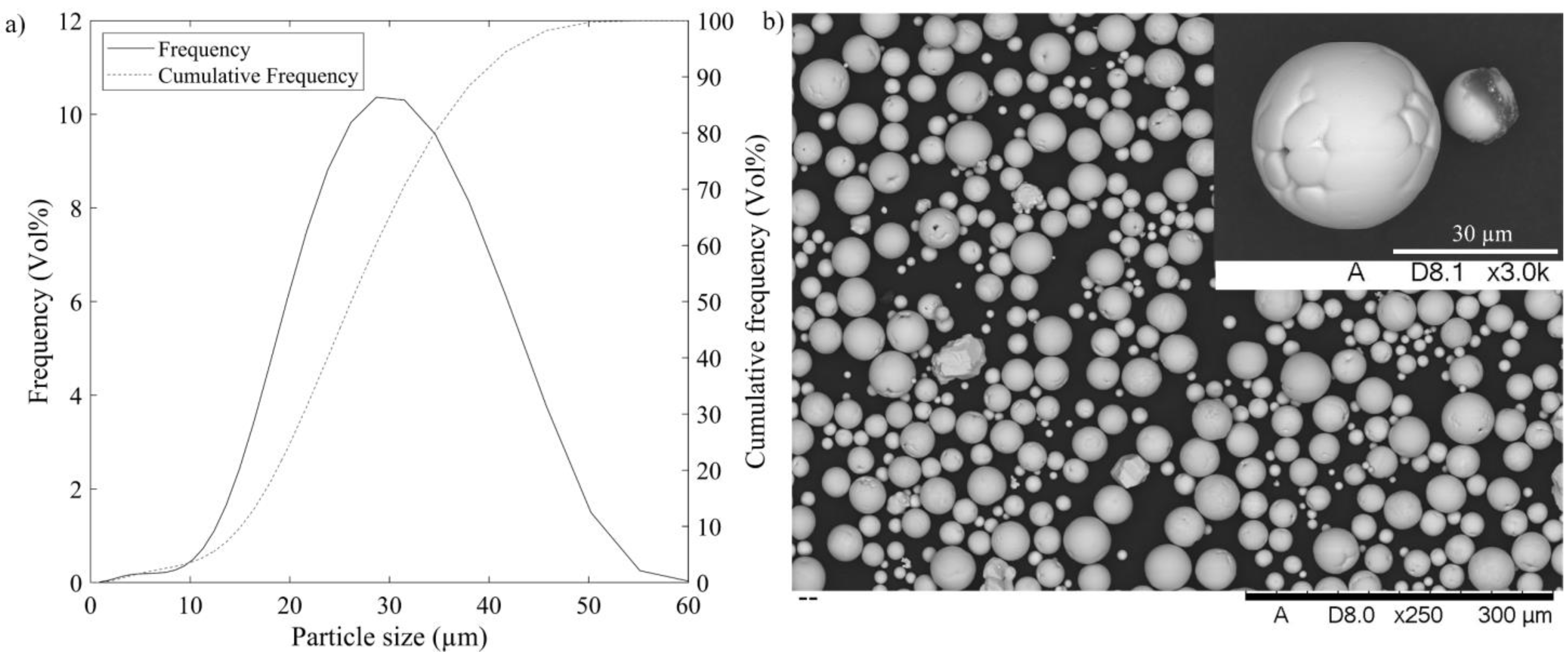

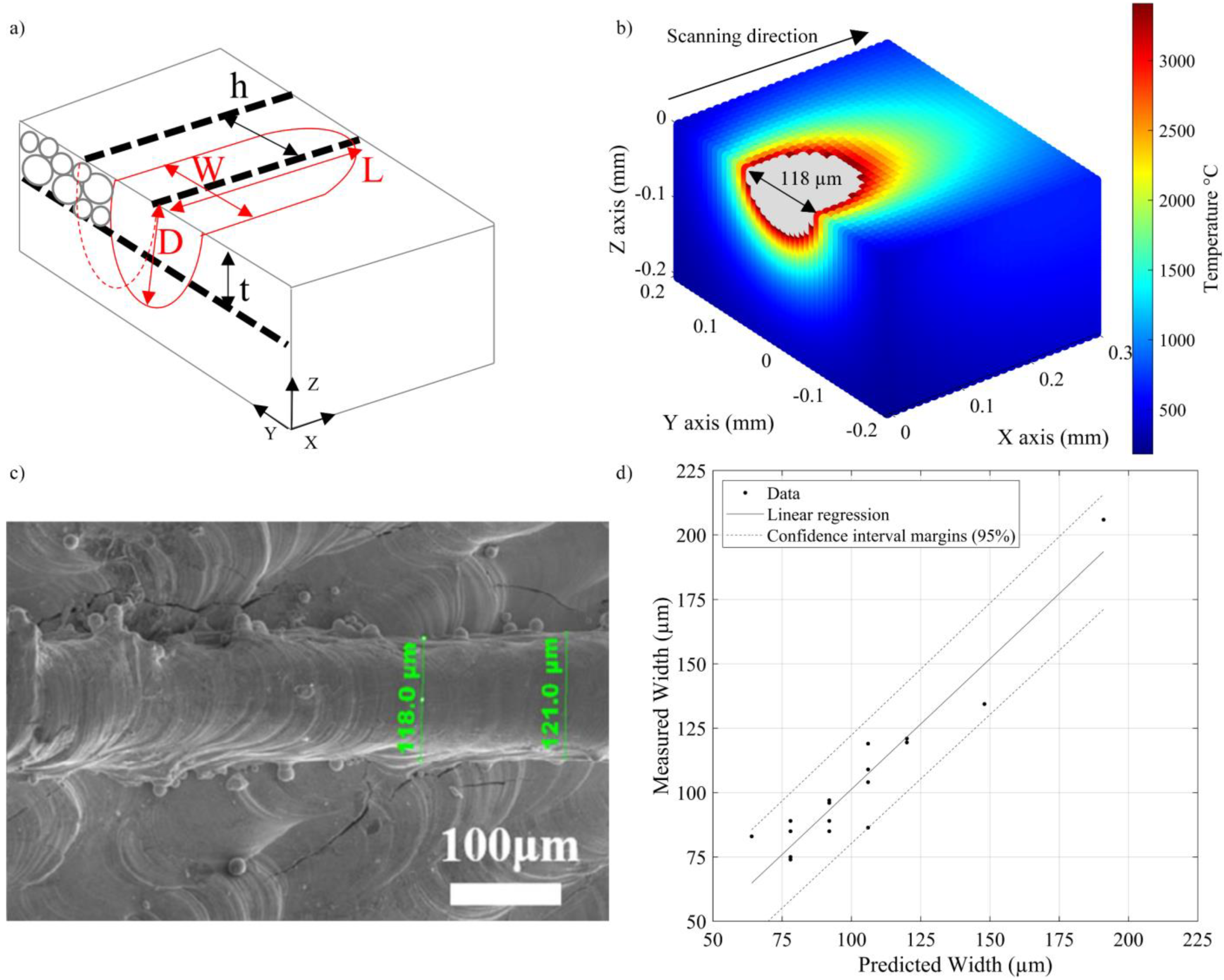
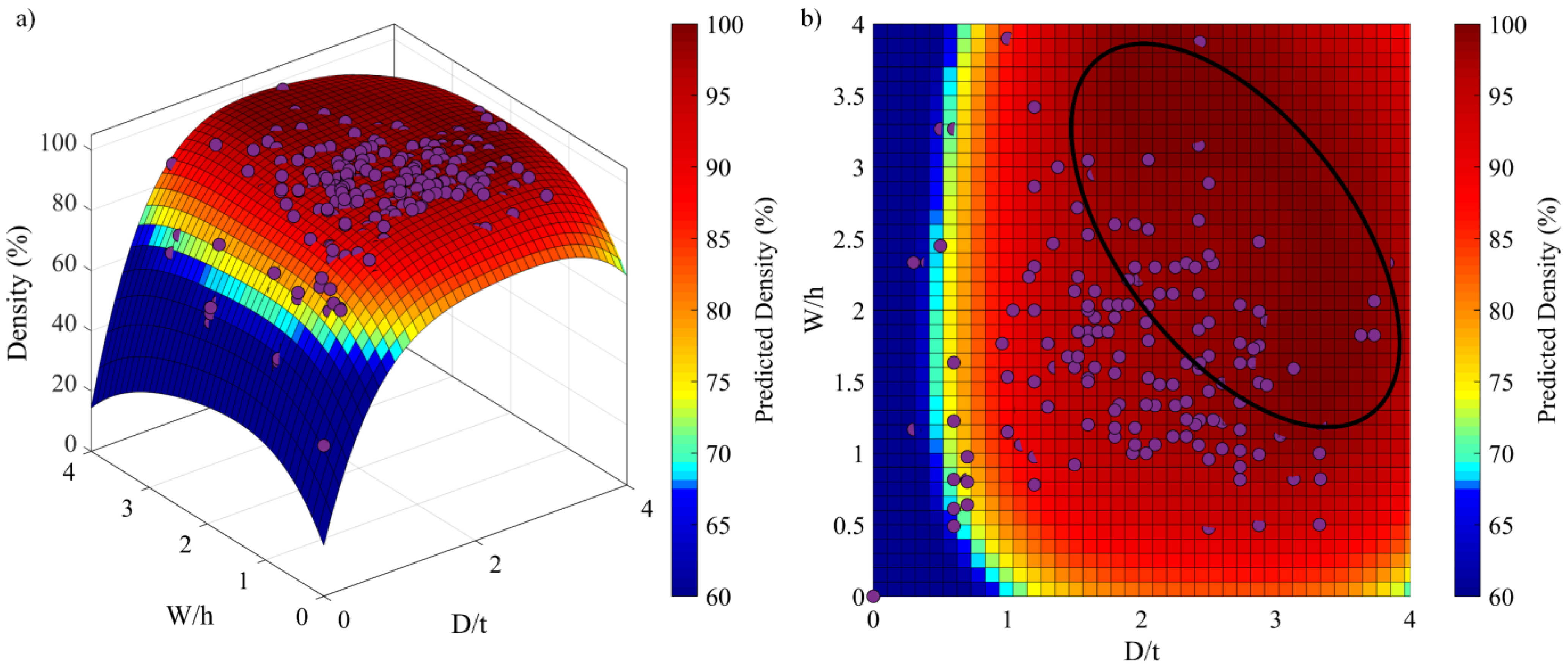





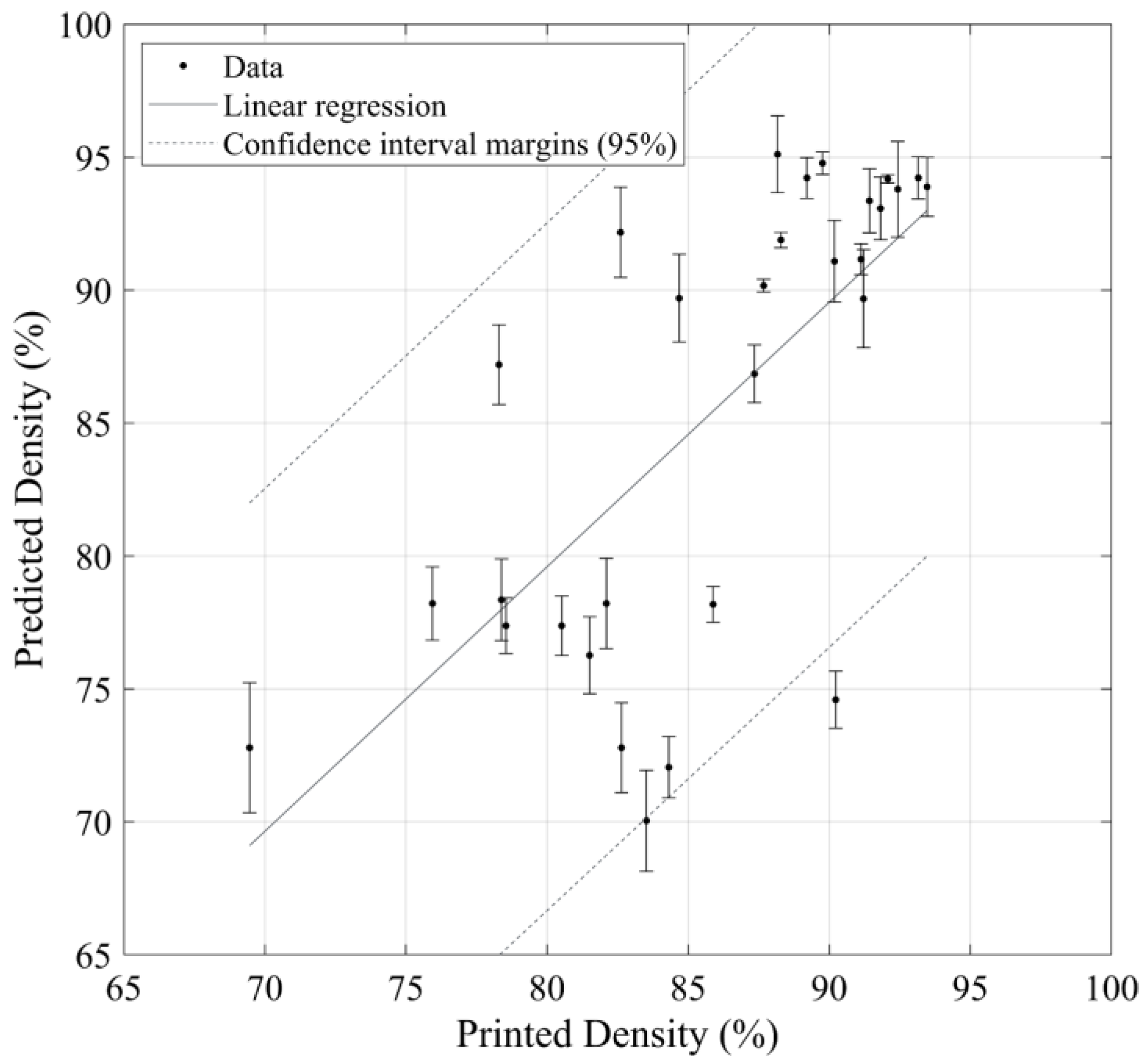


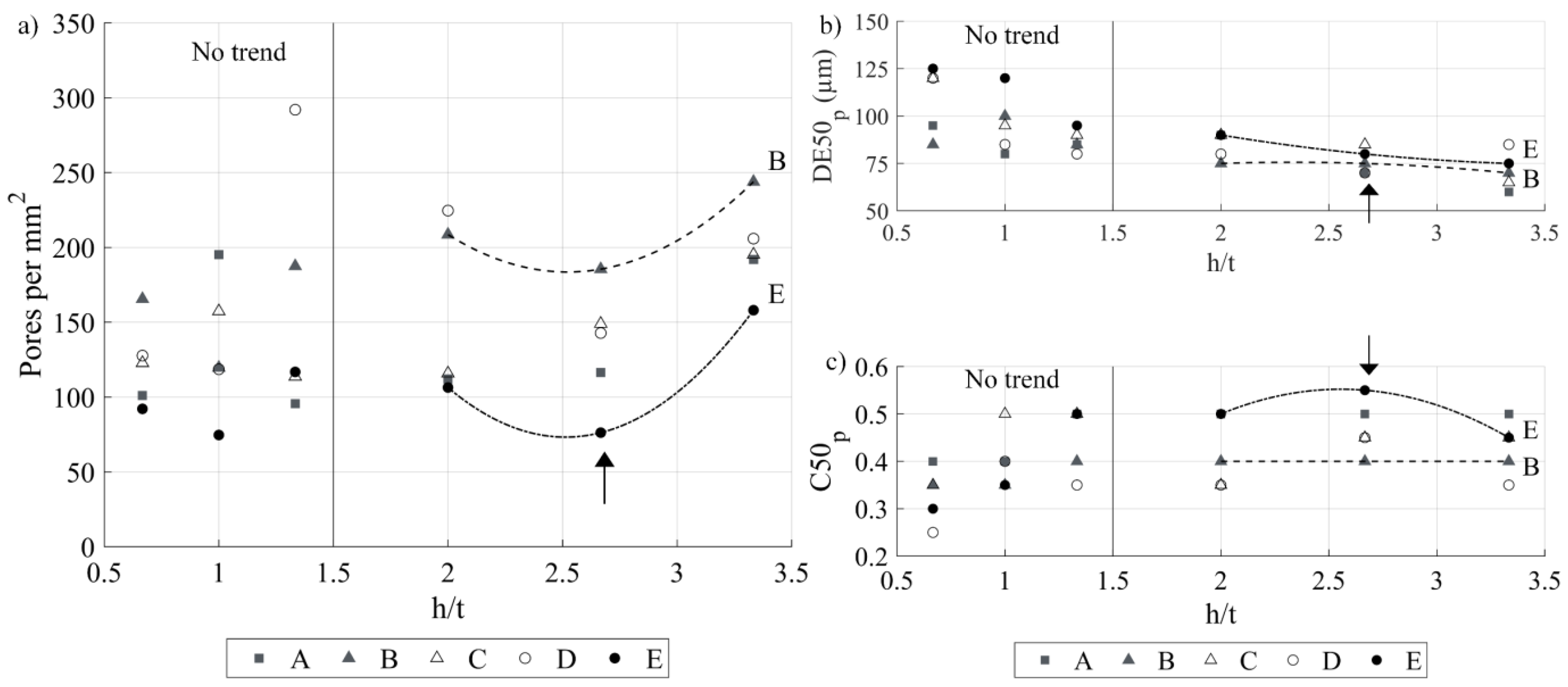
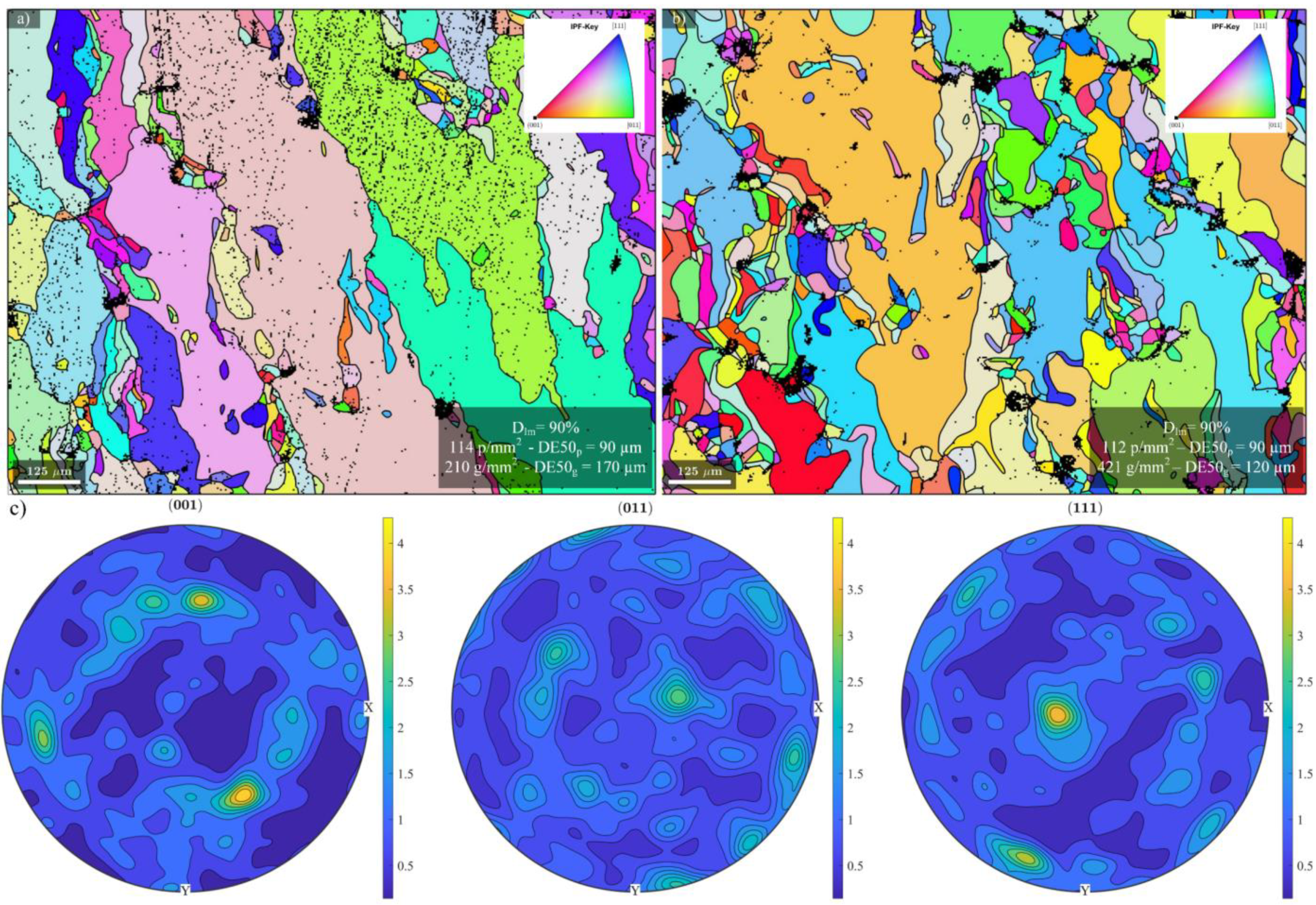
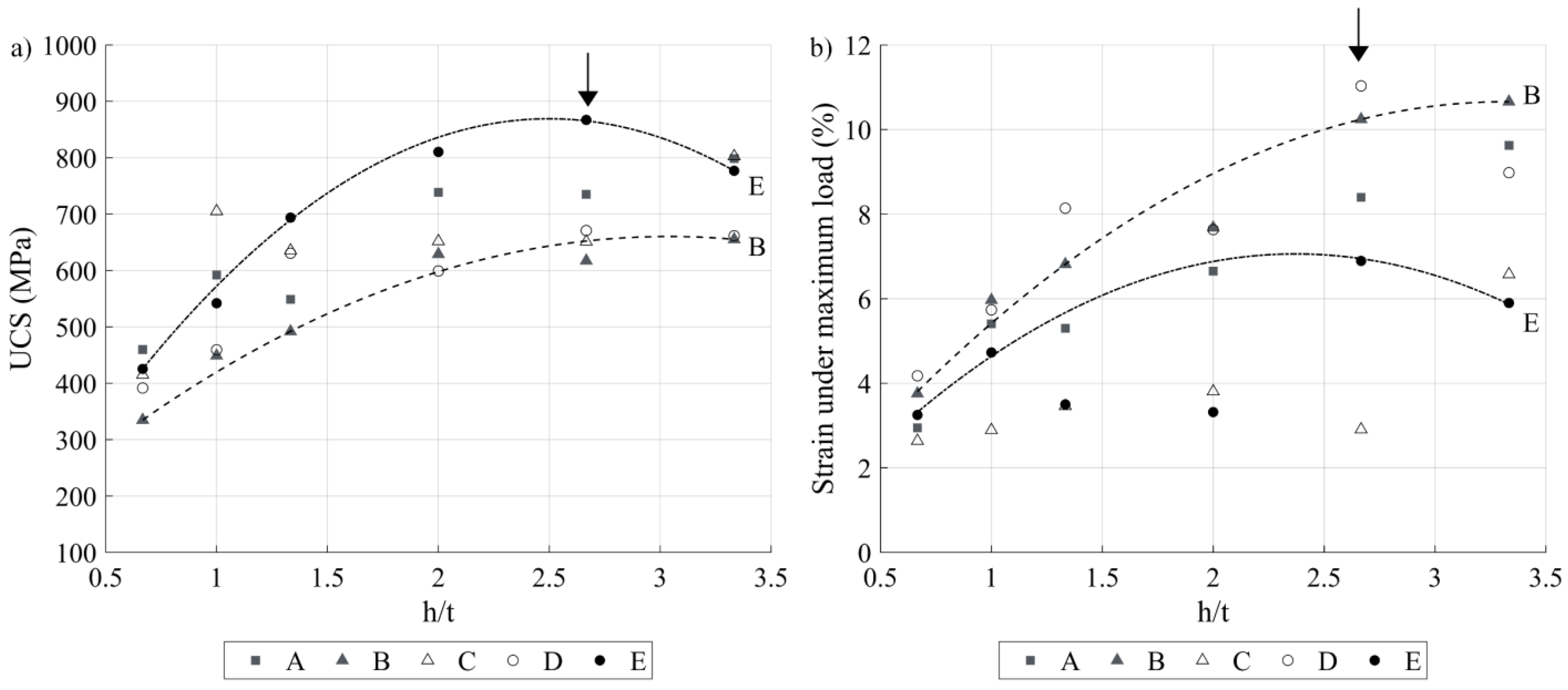
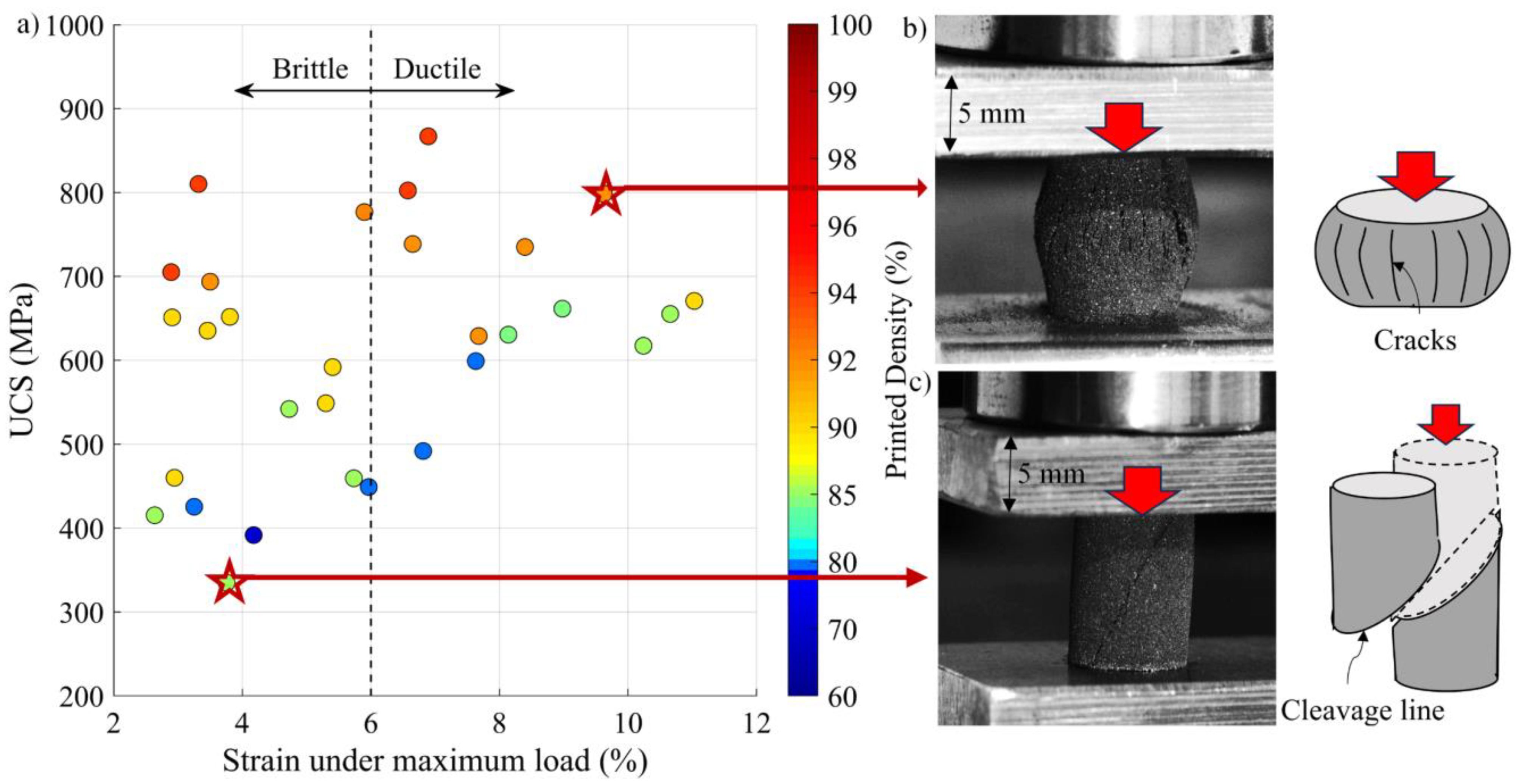
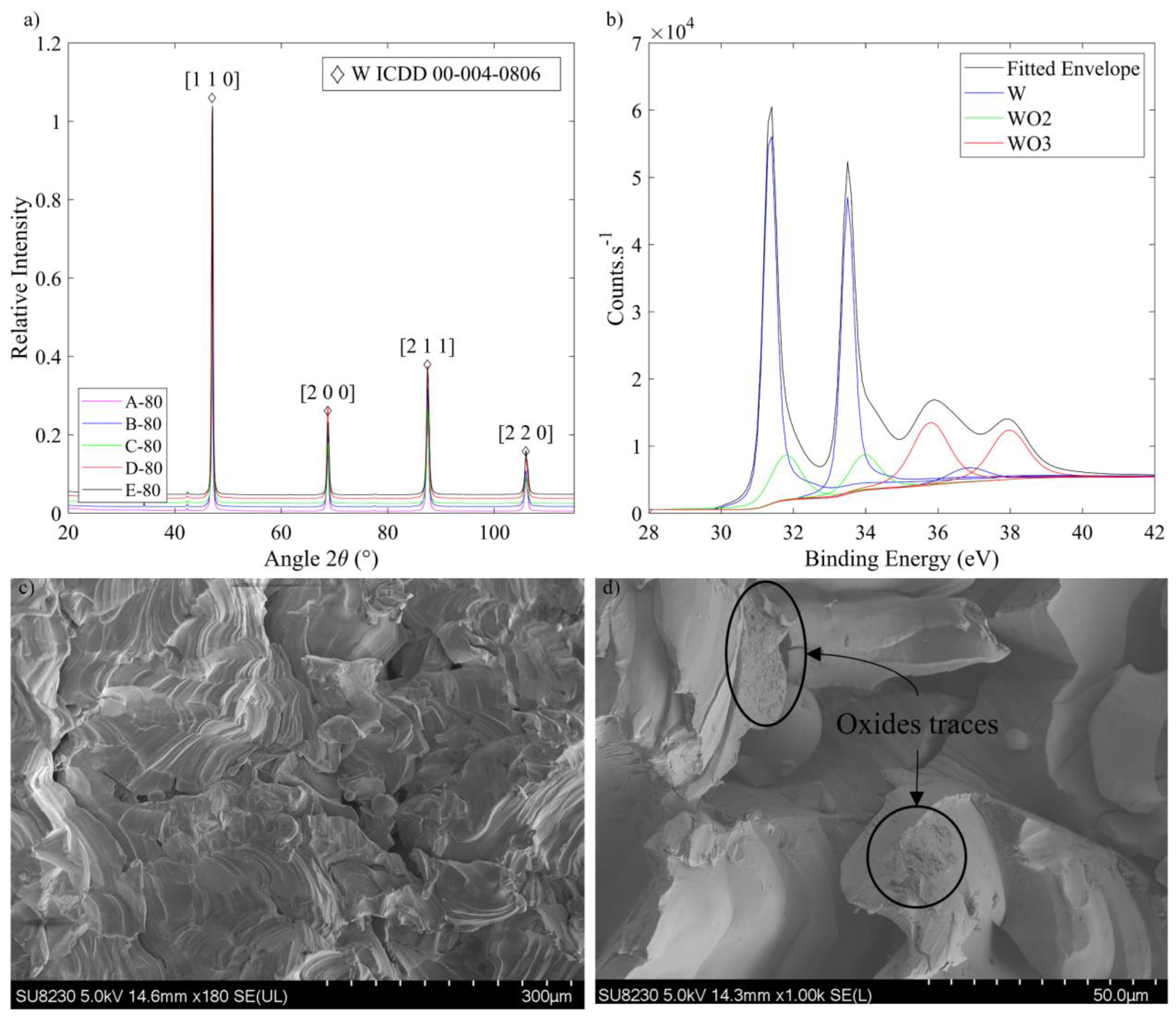
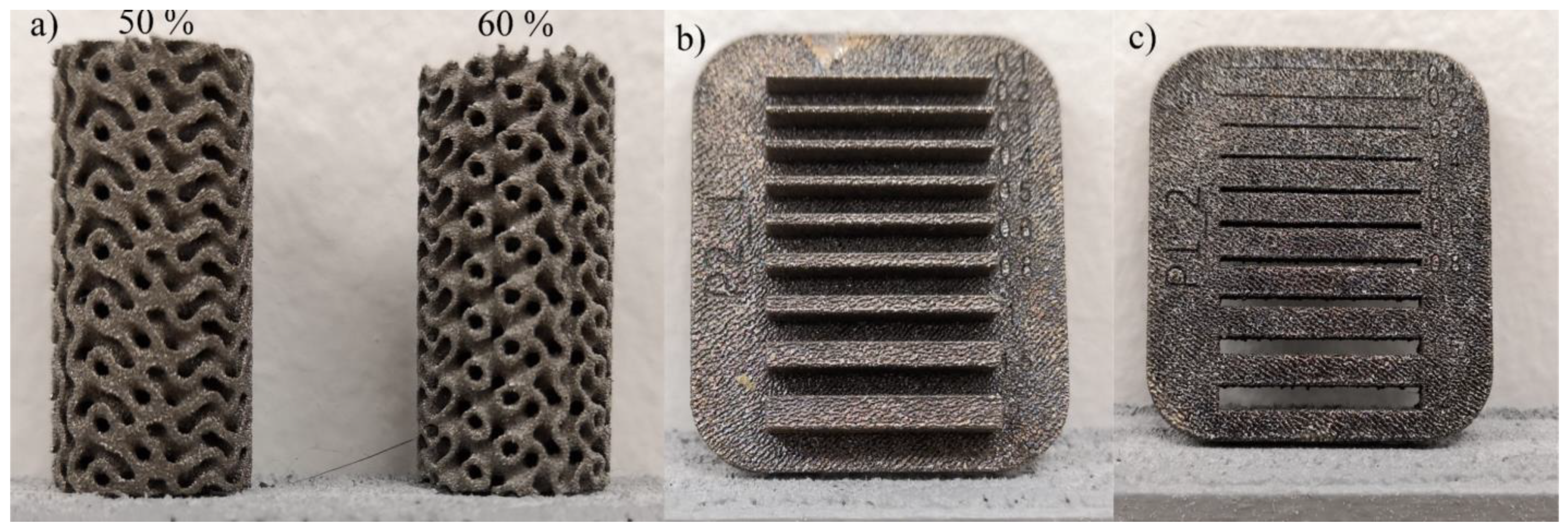

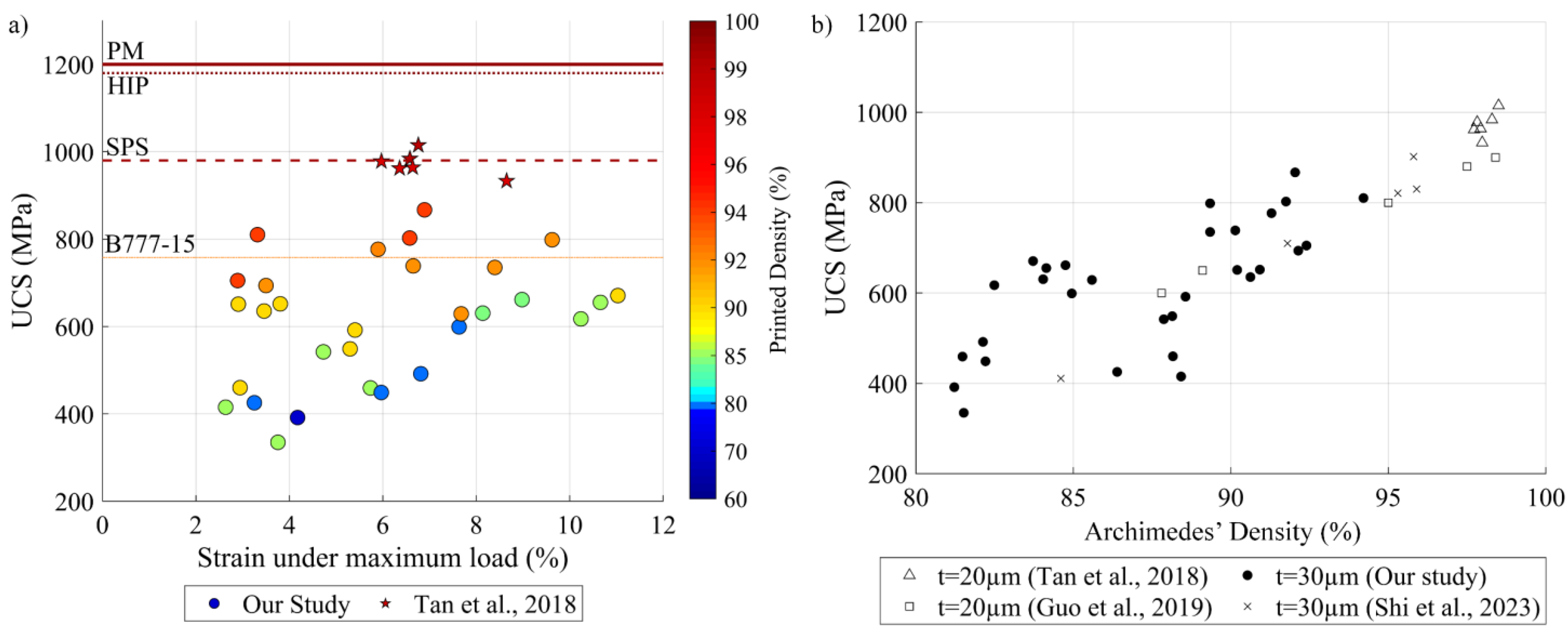
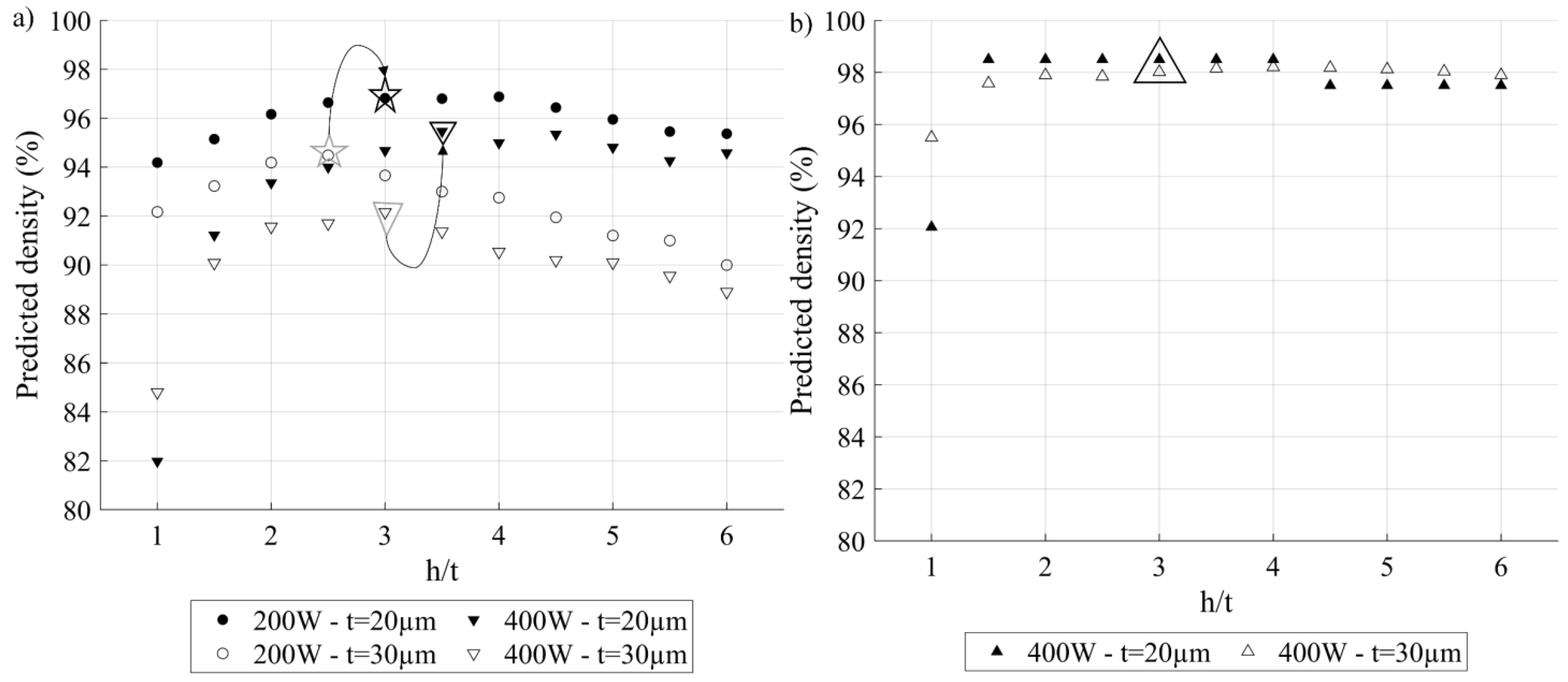
| FT4 Rheometer | ||||||||
|---|---|---|---|---|---|---|---|---|
| Carr Index | Hausner Ratio | BD (g.cm−3) | CI (%) at 15 kPa | PD (mBar) at 15 kPa | SE (mJ.g−1) | AE10 (mJ) | BFE (mJ) | CC (kPa) |
| 0.00 | 1.00 | 12.1 (±0.375%) | 1.82 (±5.08%) | 14.6 (±3.88%) | 1.62 (±0.523%) | 23.0 (±1.7%) | 1182 (±2.09%) | 0.38 |
| Temperature of Application (K) | Material Density (kg.m−3) | Bulk Density (kg.m−3) | Specific Heat Capacity (J.kg−1.K−1) | Thermal Conductivity (W.m−1.K−1) | Electrical Resistivity (nΩ.m) | Absorptivity (%) |
|---|---|---|---|---|---|---|
| 293 (RT)–3683 (TM) | 19,254 | 12,100 | 131–296 | 47–74 Equation (9) | 53–1219 | 18–51 Equations (6)–(8) |
| A | B | C | D | E | |
|---|---|---|---|---|---|
| VED, J.mm−3 | 1170 | 750 | 750 | 417 | 417 |
| BR, cm3.h−1 | 0.43 | 0.43 | 0.86 | 0.86 | 1.62 |
| Layer Thickness (µm) | Device | Power (W) | Speed (mm.s−1) | Hatching Space (µm) | (J.mm−3; cm3.h−1) | Predicted Density (%) |
|---|---|---|---|---|---|---|
| 20 | 200 W | 188 | 375 | 60 | (417; 1.62) | 96.9 |
| 400 W | 400 | 750 | 60 | (444; 3.24) | 98.7 | |
| 30 | 200 W | 188 | 200 | 75 | (417; 1.62) | 93.7 |
| 400 W | 400 | 333 | 90 | (444; 3.24) | 98.6 |
Disclaimer/Publisher’s Note: The statements, opinions and data contained in all publications are solely those of the individual author(s) and contributor(s) and not of MDPI and/or the editor(s). MDPI and/or the editor(s) disclaim responsibility for any injury to people or property resulting from any ideas, methods, instructions or products referred to in the content. |
© 2024 by the authors. Licensee MDPI, Basel, Switzerland. This article is an open access article distributed under the terms and conditions of the Creative Commons Attribution (CC BY) license (https://creativecommons.org/licenses/by/4.0/).
Share and Cite
Leclercq, A.; Brailovski, V. Improving Laser Powder Bed Fusion Printability of Tungsten Powders Using Simulation-Driven Process Optimization Algorithms. Materials 2024, 17, 1865. https://doi.org/10.3390/ma17081865
Leclercq A, Brailovski V. Improving Laser Powder Bed Fusion Printability of Tungsten Powders Using Simulation-Driven Process Optimization Algorithms. Materials. 2024; 17(8):1865. https://doi.org/10.3390/ma17081865
Chicago/Turabian StyleLeclercq, Aurore, and Vladimir Brailovski. 2024. "Improving Laser Powder Bed Fusion Printability of Tungsten Powders Using Simulation-Driven Process Optimization Algorithms" Materials 17, no. 8: 1865. https://doi.org/10.3390/ma17081865
APA StyleLeclercq, A., & Brailovski, V. (2024). Improving Laser Powder Bed Fusion Printability of Tungsten Powders Using Simulation-Driven Process Optimization Algorithms. Materials, 17(8), 1865. https://doi.org/10.3390/ma17081865








